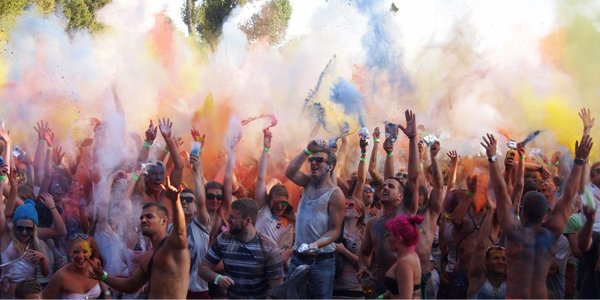What is Holi :
The colorful festival of Holi is celebrated on Phalgun Purnima which comes in February end or early March. Holi festival has an ancient origin and celebrates the triumph of ‘good’ over ‘bad’. The colorful festival bridges the social gap and renew sweet relationships. On this day, people hug and wish each other ‘Happy Holi’.
Holi celebration begins with lighting up of bonfire on the Holi eve. Numerous legends & stories associated with Holi celebration makes the festival more exuberant and vivid. People rub ‘gulal’ and ‘abeer’ on each others’ faces and cheer up saying, “bura na maano Holi hai”. Holi also gives a wonderful chance to send blessings and love to dear ones wrapped in a special Holi gifts.
How is Holi Celebrated?
People celebrate the day smearing colored powder and colored water all over each other’s faces, throwing colored water and water ballons at each other and dancing under water sprinklers. Bhang (a paste made from cannabis plants) is also traditionally consumed during the celebrations.

Holi is a very carefree festival that’s great fun to participate in if you don’t mind getting wet and dirty. You’ll end up saturated in water, with color all over your skin and clothes. Some of it doesn’t wash out easily, so be sure to wear old clothes. It’s also a good idea to rub hair oil or coconut oil into your skin beforehand, to prevent the color from absorbing.
Preparations of Holi Fesival in India :
Entire country wears a festive look when it is time for Holi celebration. Market places get abuzz with activity as frenzied shoppers start making preparations for the festival. Heaps of various hues of gulal and abeer can be seen on the roadside days before the festival. Pichkaris in innovative and modern design too come up every year to lure the children who wish to collect them as Holi memorabilia and of course, to drench everybody in the town.
Womenfolk too start making early preparations for the holi festival as they cook loads of gujiya, mathri and papri for the family and also for the relatives. At some places specially in the north women also make papads and potato chips at this time
What Rituals are Performed?
A Hindu festival, Holi has various legends associated with it. The foremost is the legend of demon King Hiranyakashyap who demanded everybody in his kingdom to worship him but his pious son, Prahlad became a devotee of Lord Vishnu. Hiranyakashyap wanted his son to be killed. He asked his sister Holika to enter a blazing fire with Prahlad in her lap as Holika had a boon which made he immune to fire. Story goes that Prahlad was saved by lord himself for his extreme devotion and evil minded Holika was burnt to ashes, for her boon worked only when she entered the fire alone.
Since that time, people light a bonfire, called Holika on the eve of Holi festival and celebrate the victory of good over evil and also the triumph of devotion to god. Children take special delight in the tradition and this has another legend attached to it. It says that there was once an ogress Dhundhi who used to trouble children in the kingdom of Prithu. She was chased away by children on the day of Holi. Therefore, children are allowed to play pranks at the time of ‘Holika Dahan’.
Some also celebrate the death of evil minded Pootana. The ogress tried to Lord Krishna as an infant by feeding it poisonous milk while executing the plan of Kansa, Krishna’s devil uncle. However, Krishna sucked her blood and brought her end. Some who view the origin of festivals from seasonal cycles believe that Pootana represents winter and her death the cessation and end of winter.
In South India, people worship Kaamadeva- the god of love and passion for his extreme sacrifice. According to a legend, Kaamadeva shot his powerful love arrow on Lord Shiva to revoke his interest in the worldly affairs in the interest of the earth. However, Lord Shiva was enraged as he was in deep mediation and opened his third eye which reduced Kaamadeva to ashes. Though, later on the request of Rati, Kaamadeva’s wife, Shiva was pleased to restore him back.
Holika Dahan :
On the eve of Holi, called Chhoti or Small Holi people gather at important crossroads and light huge bonfires, the ceremony is called Holika Dahan. This tradition is also followed in Gujarat and Orissa. To render greatfulness to Agni, god of Fire, gram and stalks from the harvest are also offered to Agni with all humility. Ash left from this bonfire is also considered sacred and people apply it on their foreheads. People believe that the ash protects them from evil forces.
Holi Safety Information :
As Holi provides an opportunity to disregard social norms and generally “let loose”, males commonly take it too far and act disrespectfully.
Single women should avoid going out alone in public places during Holi, as inebriated young Indian guys often pose a safety threat. These males, who have consumed excessive amounts of bhang and other intoxicants, will inappropriately touch women and make a nuisance of themselves. They are usually in groups and can be very aggressive.
If you plan on going out into the streets on Holi, do so early in the morning. Be back in your hotel by midday before the men get too inebriated. Many hotels hold special Holi parties for their guests in a safe environment.
Expect to have colored powder and water rubbed and thrown onto your face, mouth and ears. Keep your mouth shut and protect your eyes as much as possible.




